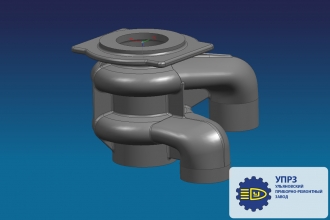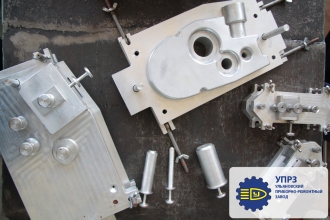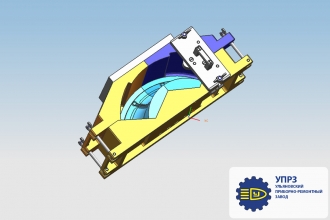Requirements for Casting Mold Casting Techniques Pattern Equipment Sand Mold Casting Die Casting Pressure Casting Investment Casting
Foundry is a branch of industry specializing in the processing of metals and their alloys, in particular the fabrication operation with different configurations by pouring molten metal into a special mold under positive pressure or by gravity, followed by cooling to solidification in the mold of the desired casting, ie finished product or bar. If necessary, the casting is then machined to ensure greater accuracy in size or reduce the surface roughness. Thus, foundry is primarily focused on the production of castings fitting the shape and size of the finished product to the greatest possible extent.
To achieve castings of high quality the fabrication shop utilizes special foundry equipment - casting molds - whose performance quality and design features to a great extent affect not only the quality of the final product, but also labor costs for production.
The fabrication shop doesimpose a number of requirements for the casting mold, including:
- Strength (ability to withstand loads)
- Ductility (due to casting shrinkage)
- Gas permeability (gases are formed in the mold while in operation)
- Fire resistance (protection against exposure to molten metal)
In terms of immediate involvement in the casting process, foundry equipment is divided into shape-generating molding tools (primary) and universal molding tools (secondary). In terms of the possible number of pouring-ins, casting molds are divided into dispensable and permanent molds, including division of molds in terms of material they are made of (sand, metal, etc.).
- Metal molds (cast iron and steel) are designed for multiple (hundreds and thousands) pouring-ins, therefore are classified as permanent molds.
- Sand molds and investment casting molds are operated by means of tooling - disposable patterns, with process of manufacturing of said molds termed as "molding". Such patterns shape the interior working space in the sand mold and are filled with molten metal to shape the casting.
The whole tooling set required for production of castings is called foundry equipment, with part of equipment used for shaping the operating surfaces in the casting mold termed as "gated pattern."
Foundry products of high-melting-temperature alloys are widely used in industries such as aircraft engineering, instrument engineering, rocket production, shipbuilding, radioelectronics and nuclear power engineering, with that of corrosion-resistant and heat-resistant alloys used in the chemical industry. Today, 50% to 95% of industrial equipment parts are manufactured by casting.
Present-day foundry widely uses about fifty casting techniques, with the following having the widest application:
- Pressure Casting
- Sand Mold Casting
- Investment Casting
- Metal Mold (Die) Casting
- Low-Pressure Casting
- Shell Mold Casting
- Centrifugal Casting, etc.
The staff of Ulyanovskiy Priboro-Remontniy Zavod has a wealth of experience to design and manufacture foundry equipment for casting non-ferrous metals and alloys , namely: die casting, sand mold casting, pressure casting, as well as to carry out a full mold construction cycle for the investment casting.
Gated Patterns (Equipment) - Sand Mold Casting
A gated pattern is production tooling, including accessories that form the working space of the mold; it includes gating patterns, plate patterns, core magazines, assembly and test patterns, as well as a foundry pattern, ie accessory used to make an impress in the casting mold, with size and configuration of such impress corresponding to the required casting.
Pattern production definitely provides for machining allowance for the ready-made casting, with said allowance underlying the design drawing of the casting. In addition, the pattern size must exceed the size of casting by the size of casting shrinkage of the alloy. These and many other technological features should be considered by experts in the design.
Foundry patterns can be split and one-piece, consisting of two or more parts. In terms of material of construction, patterns can be mainly plastic, metal and wood, as the pattern should be both strong and rigid, but light. Wood patterns are made of separate bonded billets to avoid warping, with direction of wood grains being of prime importance.
Wood patterns have some pros, in particular ease of manufacture, moderate cost, light weight, as well as cons, in particular short life, warping, water-absorbing capacity, structural imperfection. Metal patterns are used in the production castings in large quantities, ie mass production. Such patterns are more durable, have a more precise working space, but are prone to oxidation and have considerable weight. Patterns are made of various alloys, ie based on aluminum, steel, bronze, brass, and cast iron as a function of specific features of operation of such equipment and its operating conditions. Plastic patterns combine the pros of metal and wood patters, as they are light, highly accurate, strong, resistant to warping, moisture proof. Plastic patterns are generally made from formaldehyde and epoxy resin based compositions.
In these latter days, sand mold casting has rare application in industries, for the most part at major plants of aeronautic, mechanical engineering and automotive manufacture. As a result, there are very few designers and engineers specializing in this type of casting. Our company staff has professionals with hands-on experience in this rather sophisticated area.
The main difficulty is the presence of a large number of core magazines, loose parts, as well as the need to create two-sided patterns. We can make metal mold equipment of aluminum and steel. Such equipment can be used for pouring nonferrous and ferrous metals and alloys, as well as cast iron.
Die Casting
Die casting is carried out either by means of stationary chill molds or chill casting machines and machine tools. The manufacture of this type of equipment requires superior skills in engineering and tool-making facilities.
Our company has all the things needed for the design and manufacture of chill molds of any complexity, including with subsequent reference to the customer's equipment. Custom-made equipment is most often tested by means of in-house equipment and facilities. We organize site visits of our specialists as part of the technical assistance in the start-up of equipment at the customer's facilities.
Pressure Casting of Nonferrous Metals and Alloys
This kind of casting has gained ground recently. Castings produced by pressure casting are used in the manufacture of furniture, household appliances, automobile construction and many other industries. Such products are very durable, leakproof and have a good marketable condition. Equipment for pressure casting of metals and alloys is designed for hundreds of thousands, even millions of molding cycles, however, is rather difficult-to-make and expensive.
There are many types of pressure casting machines for the operation of said equipment, with production range constantly kept up to date. They are divided into casting machines with horizontal and vertical pressure chambers. Each of these types has its own series in size, capacity, design features and manufacturers.
Our company has successfully performed the design, manufacture and commissioning of molds for metal casting of items used in mechanical engineering, as well as for manufacture of household appliances.
Molds for pressure casting of non-ferrous metals and alloys can have different degrees of complexity: with slides, hydraulic cylinders, inclined pushers, inserts, single-cavity, multiple cavity, multiple parting planes, etc. We have vital skills and equipment for the manufacture of tooling of any complexity. In most cases, we have opportunities for operation of said tooling on using in-house facilities.
Investment Casting
Investment casting is most often used in the production of thin-walled odd-shaped castings both in mechanical engineering and art industry. This is one of the oldest casting methods for manufacture of statues, bells, cannons. A characteristic feature of this type of casting is that each pattern can be used for one casting only as it undergoes sweating in the course of mold production, and the molding sand mixture itself is made not from a homogeneous molten metal, but from the refractory fine dusty material in the binder solution. It is the mixture design that contributes to obtaining castings with high surface quality. The precision of the pattern impress is provided by increased metal temperature, thus investment and binder materials should have a high fire resistance. The con of this method is a long and lengthy casting manufacturing process, which requires tailor-made expensive tooling and highly trained and qualified specialists.
This type of casting is used for the casting of ferrous and non-ferrous metals and alloys. The mold design is very diverse and differs according to the planned potential output and equipment, on which tooling will be operated.
In mechanical engineering, wax casting patterns are made in plaster, plastic and metal molds; the manufacturing process is usually power-actuated and computer-aided. The investment casting method produces parts for aeronautic, instrument-making, mechanical engineering and some other industries utilizing casting techniques involving difficult-to-machine, heat-resistant and corrosion-resistant alloys.
Investment casting tooling disassembly can be power-actuated (designs are similar to molds for pressure casting) and manual (structurally more diverse and produce more castings with more sophisticated geometry). If the product requires a high degree of accuracy, strength and leak-tightness, aluminum castings of said casting type are more preferable than pressure castings. Investment ferrous metal casting produces more precise and beautiful items as opposed to sand casting. Our company can fulfill any order for the design and manufacture of equipment for investment casting, including with reference to the customer's equipment.



